10 Essential Elements of an Effective Enterprise Data Strategy

10 Essential Elements of an Effective Enterprise Data Strategy
Overview
This article presents ten essential elements of an effective enterprise data strategy. Key features include:
- Data governance
- Technology investment
- Self-service analytics
- Performance measurement
Each of these elements plays a crucial role in shaping how organizations manage and utilize their data.
Why is a well-structured data strategy important? It enhances decision-making, boosts operational efficiency, and ensures compliance. For instance, organizations that invest in robust data governance frameworks can significantly reduce risks associated with data breaches and regulatory penalties. Similarly, self-service analytics empowers employees to make data-driven decisions without relying heavily on IT departments.
Moreover, performance measurement allows organizations to track the effectiveness of their data initiatives. By analyzing relevant metrics, businesses can identify areas for improvement and adjust their strategies accordingly. This proactive approach not only fosters a culture of continuous improvement but also drives better outcomes.
In conclusion, implementing these ten elements can transform how organizations leverage data. Are you ready to enhance your data strategy? Consider how these insights can be applied to your own organization for improved results.
Introduction
In an age where data drives decision-making, having a well-structured enterprise data strategy is crucial. Organizations are increasingly recognizing that a comprehensive approach not only boosts operational efficiency but also fosters innovation and competitive advantage. This article explores ten essential elements that form the backbone of an effective enterprise data strategy, detailing how these components empower organizations to fully leverage their data assets.
Yet, as companies strive for data-driven success, they often encounter the challenge of aligning their strategies with business objectives. How can they ensure that their data initiatives translate into tangible results? By understanding the features, advantages, and benefits of a robust data strategy, organizations can navigate this complex landscape more effectively.
Initial Data Offering: Centralized Hub for Dataset Discovery
The Initial Data Offering (IDO) serves as a centralized hub that streamlines the process of launching and discovering new datasets. What makes IDO stand out? By curating high-quality and unique collections, it enhances accessibility for businesses, researchers, and organizations, tackling the prevalent issue of fragmented information marketplaces. This platform effectively connects information providers with potential purchasers, ensuring users have access to the latest trends and insights.
The advantages of IDO are clear. With 78% of companies already adopting an enterprise data strategy, the benefits include improved efficiencies and enhanced decision-making capabilities. Successful examples of platforms that have streamlined dataset launches highlight the potential for organizations to effectively leverage their enterprise data strategy. This not only fosters innovation but also supports strategic planning across various sectors.
Moreover, expert insights underscore the importance of community involvement in information platforms. Why is this significant? Community engagement fosters collaboration and knowledge exchange, ultimately leading to better outcomes for all parties involved. By nurturing a vibrant environment of information enthusiasts, IDO establishes itself as a preferred choice for information exchange, paving the way for a more connected and informed future.

Data Governance: Ensuring Quality and Compliance
Efficient information governance is essential for establishing robust policies and procedures within an enterprise data strategy that guarantee accuracy, security, and compliance with regulations like GDPR and HIPAA. Organizations face significant compliance challenges, with 54% identifying information governance as a primary integrity concern, just behind information excellence at 56%. To effectively navigate these complexities, businesses must incorporate their enterprise data strategy by:
- Assessing their information landscape
- Clearly defining ownership
- Implementing strict controls for managing access and usage
An effective enterprise data strategy for ensuring information integrity includes:
- Regular audits
- Automated assessments
- Fostering a culture of accountability among information stewards
This approach not only enhances information integrity but also mitigates risks associated with breaches and non-compliance, which are critical considerations in an enterprise data strategy, as they can lead to costly penalties and reputational damage.
The importance of an enterprise data strategy focused on information quality and compliance cannot be overstated; organizations that prioritize these elements report improved analytics and insights, with 58% citing enhanced information quality as a key benefit of their governance programs. For instance, organizations that have adopted comprehensive information governance frameworks as part of their enterprise data strategy, such as those from McKinsey, PwC, and DAMA, have seen significant improvements in operational efficiency and risk management.
Leaders in information governance emphasize that an effective enterprise data strategy is essential for ensuring transparency and accountability in managing information assets. As Rachel Galvez noted, "Information governance is the compass that directs entities towards information quality excellence, ensuring that every piece of knowledge is a valuable asset for decision-making." By establishing clear roles and responsibilities, companies can foster collaboration and break down barriers, leading to better information management and decision-making.
Moreover, organizations must recognize potential obstacles to effective governance, including cultural, structural, technical, and security challenges. As the landscape of information governance evolves, maintaining a focus on these principles will be crucial for entities aiming to effectively leverage their enterprise data strategy.
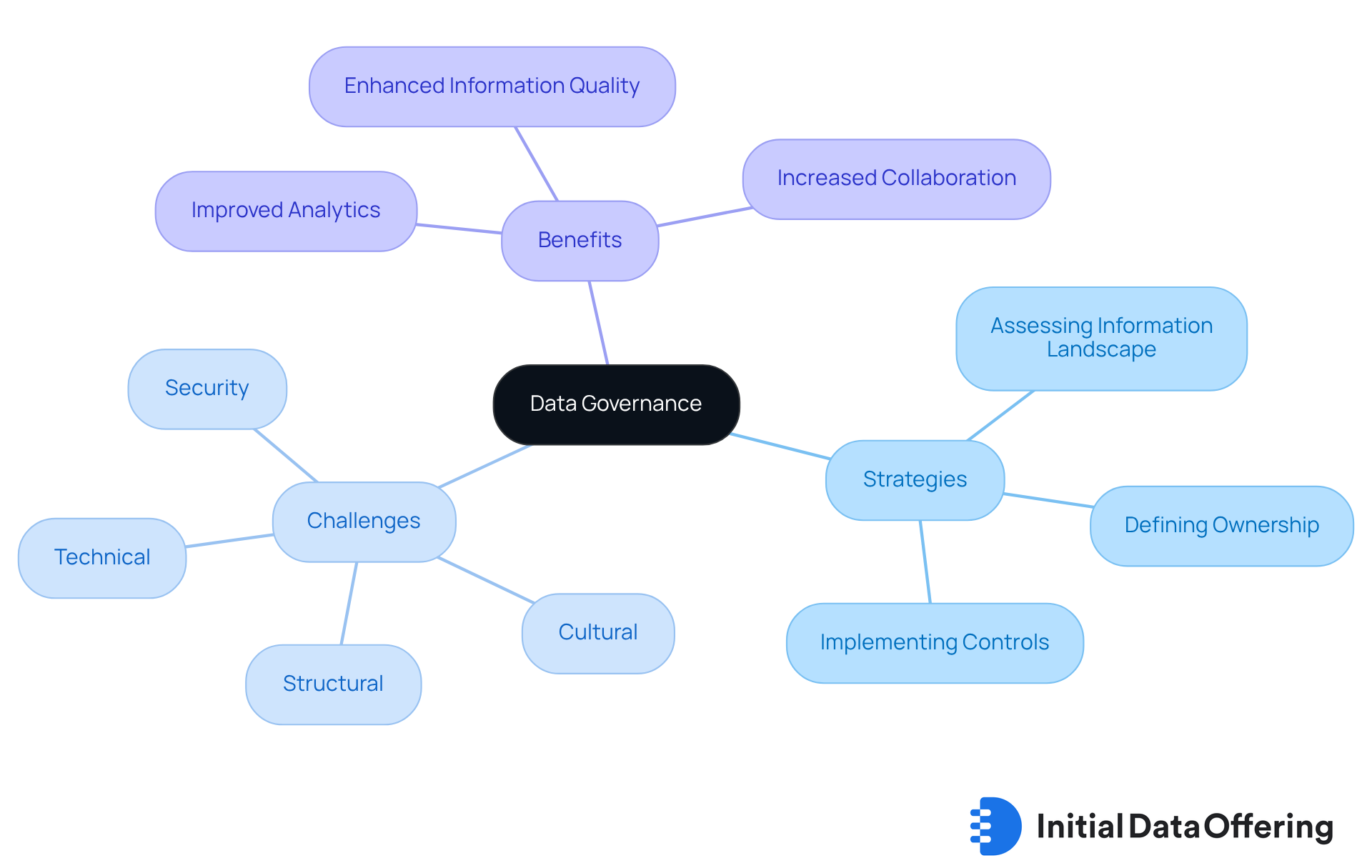
Business Objectives: Aligning Data Strategy with Goals
To enhance the effectiveness of information initiatives, organizations must ensure their strategy aligns with overarching organizational goals. Involving stakeholders is essential for establishing clear, measurable objectives and recognizing particular use cases that information can effectively tackle.
For instance, companies like Slevomat have successfully connected their information initiatives to commercial results, leading to a 23% rise in sales after transitioning to a more efficient information management platform. Similarly, Red Roof Inn leveraged information on flight cancellations to launch targeted marketing campaigns during adverse weather, achieving a 10% increase in turnover. By directly linking information initiatives to business results, companies can improve their market positioning and stimulate substantial growth.
Expert insights reveal that organizations lacking a clear information strategy experience 35% slower decision-making processes and miss out on up to 40% of potential growth opportunities, according to McKinsey & Company. Consequently, setting quantifiable targets for information initiatives is crucial for fostering a culture focused on analytics that aligns with strategic aims and enhances competitive edge.
How can your organization ensure that its information initiatives are effectively aligned with its goals? By establishing measurable objectives and recognizing specific use cases, you can drive significant improvements in performance and growth.
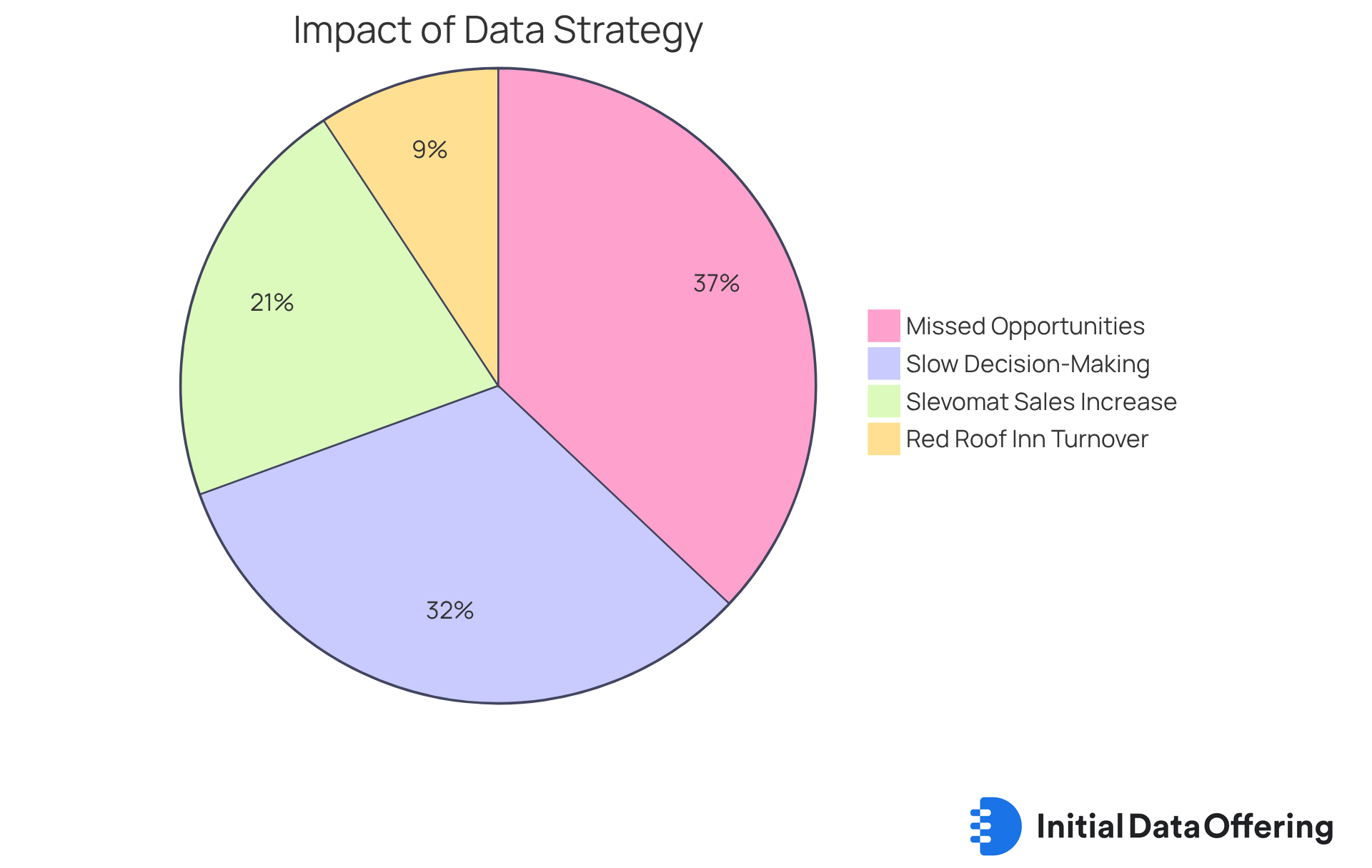
Technology Investment: Enabling Efficient Data Utilization
Organizations must prioritize investments in technology that support their enterprise data strategy to enhance information utilization. This includes robust information management platforms, advanced analytics tools, and cloud solutions. Statistics reveal that nearly 65% of enterprises have either embraced or are exploring AI technologies for analysis. This shift underscores a significant move towards information-driven decision-making.
However, challenges persist. Inadequate information quality costs firms approximately 12% of their revenue each year. Additionally, the need for robust governance frameworks is critical for enhancing the effectiveness of analytics efforts within an enterprise data strategy. By establishing scalable infrastructure as part of their enterprise data strategy, companies can efficiently manage increasing information volumes and complexity, ensuring they remain competitive in a rapidly evolving landscape.
Industry leaders emphasize the importance of leveraging analytics tools to drive innovation. For instance, companies that implement personalization strategies often experience revenue uplifts of 10-15%. Furthermore, cloud solutions facilitate real-time information sharing and collaboration, enabling organizations to derive actionable insights.
Significant examples illustrate these benefits:
- JPMorgan Chase utilized large-scale analytics to enhance loan underwriting precision and reduce default rates.
- Massachusetts General Hospital employed predictive analytics to decrease hospital readmissions by 22%.
These cases highlight the tangible advantages of effective information utilization.
As organizations continue to adopt these technologies, they position themselves to unlock new opportunities and enhance operational efficiency. How can your organization leverage these insights to improve its analytics capabilities?

Self-Service Analytics: Empowering Data-Driven Decisions
Self-service analytics tools empower users to independently explore data and generate insights, eliminating the need for reliance on IT or analytics teams. These tools feature intuitive interfaces and advanced data visualization capabilities, enabling employees at all levels to make informed, evidence-based decisions. This democratization of information access not only boosts productivity but also cultivates a culture of continuous improvement and innovation.
Consider this: the global self-service analytics market is projected to reach USD 24.4 billion by 2035, growing at a CAGR of 15.9% from 2025 to 2035. This trend underscores the increasing importance of democratizing information. Companies that have adopted self-service analytics report significant enhancements in operational efficiency. In fact, over 600 companies in France are expected to implement such solutions by 2025, driven by government digitization initiatives.
The BFSI sector is particularly noteworthy, anticipated to account for 30% of the self-service analytics market by 2025. This illustrates how democratizing information can lead to rapid insights and flexible analytical capabilities, ultimately enhancing decision-making and strategic resource allocation. As employees become more comfortable with data analysis, organizations experience cascading benefits in problem-solving and innovative thinking. This nurtures a culture where evidence-based decision-making becomes the norm.
How might your organization leverage self-service analytics to drive similar outcomes? By embracing these tools, you can foster a more agile and informed workforce.
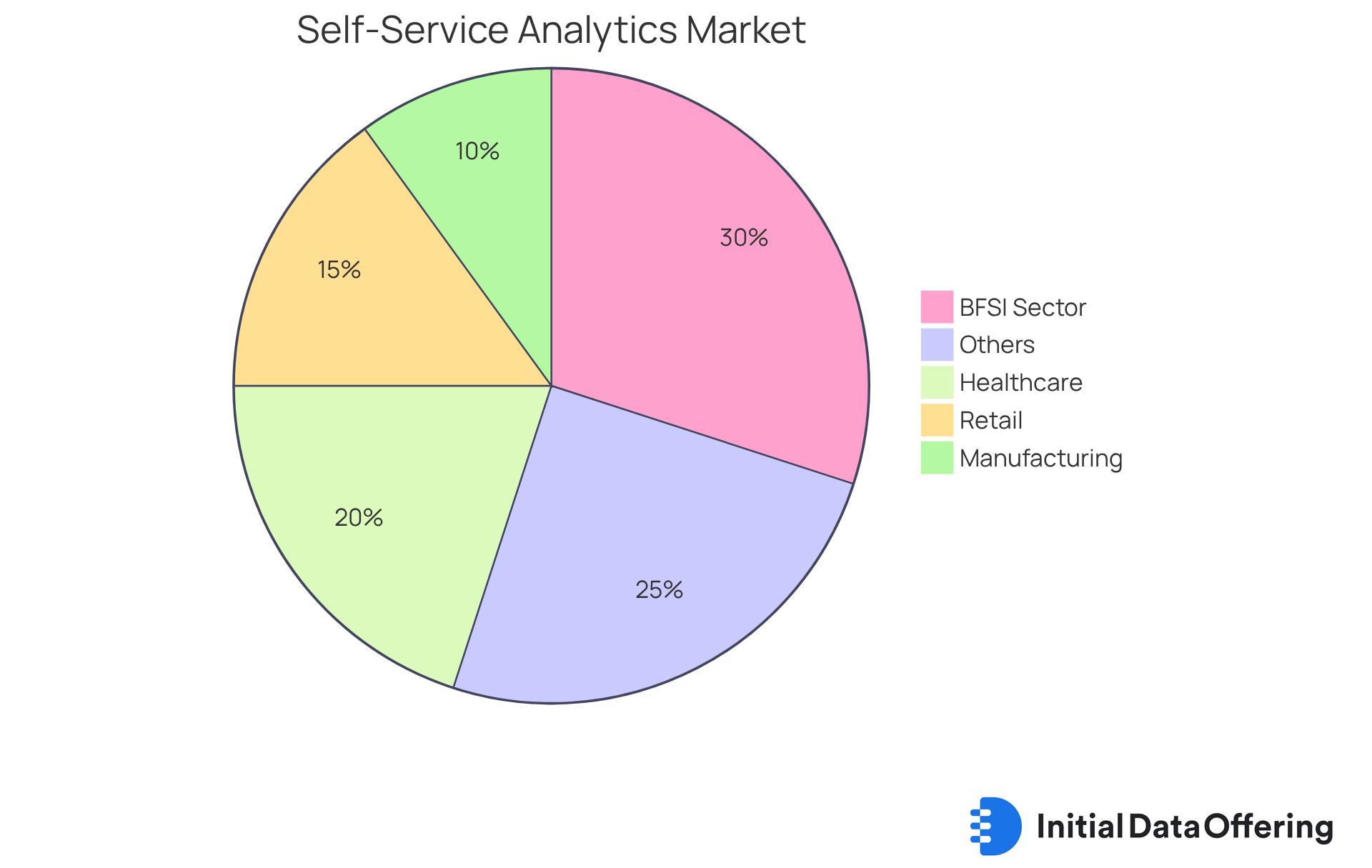
Data Culture: Fostering Collaboration and Insight
Cultivating an enterprise data strategy is essential for organizations aiming to thrive in today’s competitive landscape. A steadfast commitment to transparency and collaboration is crucial. By prioritizing open communication about information usage and insights, companies create an environment where employees feel empowered to share their discoveries. This approach not only fosters innovation but also enhances overall performance. For instance, companies like The North Face effectively utilize consumer information to tailor user experiences, showcasing the tangible benefits of information literacy in action.
To enhance information literacy, organizations can implement targeted training initiatives that underscore the significance of data in driving innovation and maintaining a competitive edge. Thought leaders often state that 'information, like oil, is only valuable when properly extracted and analyzed.' This highlights the necessity for effective management practices. Additionally, addressing the challenges analysts face in contextualizing unrefined information is vital, as it reveals the complexities involved in nurturing a culture driven by insights. Organizations must also recognize the importance of cleansing data before analysis, ensuring that insights are both precise and actionable.
Moreover, having specific questions or challenges in mind before gathering information is crucial for maximizing its value. By fostering a culture that values information as a strategic resource, companies can enhance their enterprise data strategy, unlocking the potential for improved decision-making and enhanced collaboration among teams. This approach not only empowers employees but also aligns with the growing recognition that data-driven enterprises are significantly more likely to outperform their competitors.
How can your organization leverage these insights to drive better outcomes?

Performance Measurement: Continuous Improvement of Data Strategy
To drive the success of an enterprise data strategy, organizations must adopt robust performance measurement frameworks that align with their defined objectives. Establishing key performance indicators (KPIs) is crucial for evaluating the effectiveness of information initiatives. This allows businesses to make informed modifications as needed.
Typical KPIs include:
- Time-to-insight
- Model accuracy
- Information integrity scores
- Query performance
- Project ROI
Together, these metrics provide a comprehensive perspective on performance. Frequent evaluations of these metrics not only promote a culture of ongoing enhancement but also enable organizations to refine their enterprise data strategy and adapt to changing market conditions.
For instance, organizations utilizing real-time metrics have reported double-digit enhancements in employee productivity. Additionally, contemporary workplaces that adopt a comprehensive approach to information quality report a remarkable 55% increase in productivity. Furthermore, 42% of global information leaders recognize improving information literacy as a vital aspect of information strategy efficacy, viewing it as the second most significant criterion.
Leadership dedication is also crucial for steering digital transformation efforts, ensuring that information initiatives align with broader organizational objectives. By emphasizing KPIs and nurturing a culture of accountability, companies can significantly enhance their initiatives' success rates through an effective enterprise data strategy, ultimately leading to improved outcomes.
How can your organization leverage these insights to boost productivity and align with strategic goals? Consider the implications of adopting a robust performance measurement framework.
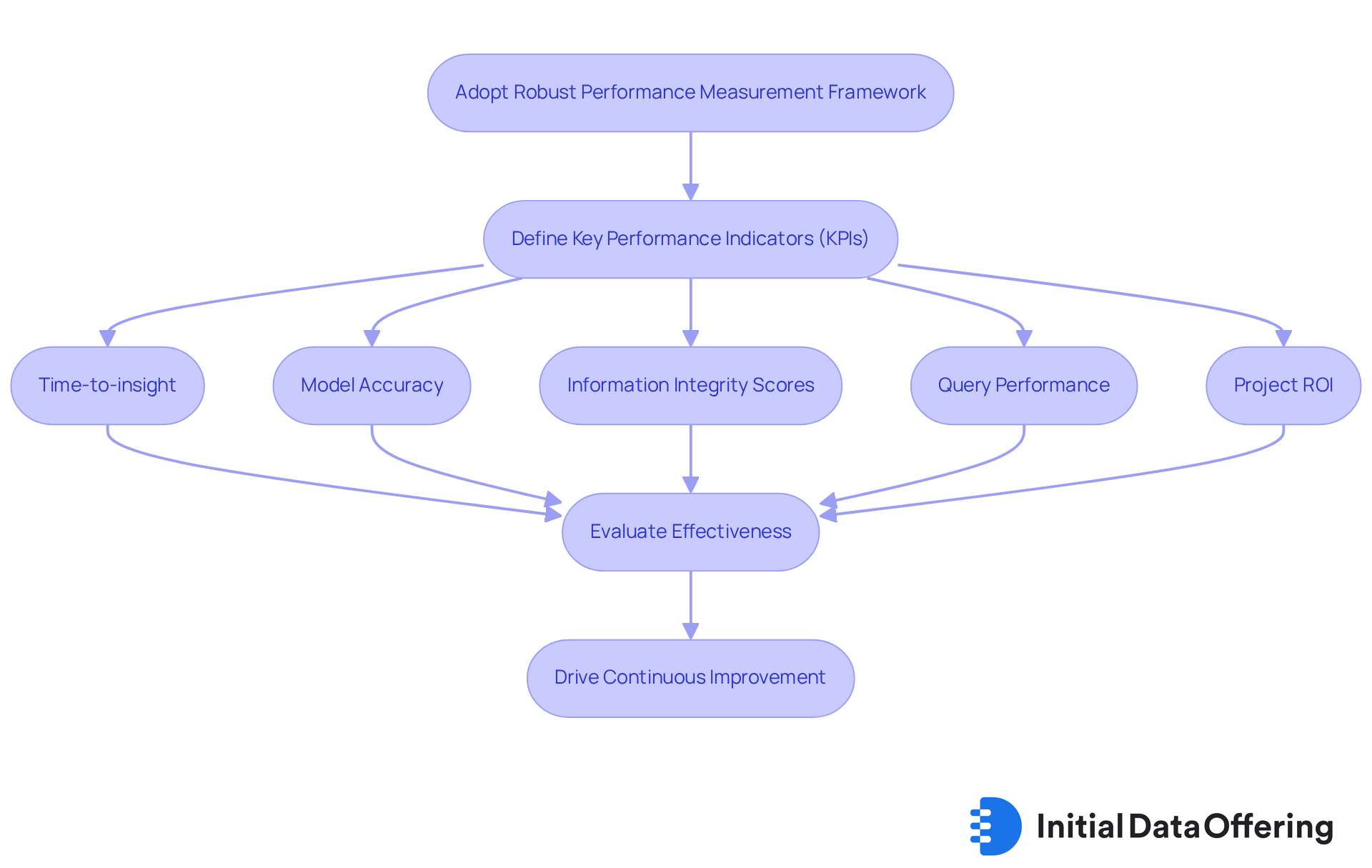
Data Silos: Breaking Down Barriers for Accessibility
Dismantling information silos is essential for enhancing accessibility and fostering collaboration within organizations. By consolidating various information sources into a centralized repository, businesses ensure that all stakeholders have timely access to the details they need. This integration not only improves the quality and speed of decision-making but also nurtures a collaborative culture where insights are shared freely across teams.
Organizations that effectively eliminate information silos often experience significant advancements in operational efficiency and innovation. For instance, firms that utilize consolidated information access report returns on investment that can be up to six times greater. This illustrates the substantial impact that integrated information can have on business performance. As Jim Liddle, Chief Innovation Officer of Data Intelligence & AI, points out, effective collaboration is not just beneficial; it is crucial for competitiveness and growth.
Moreover, Roman Vinogradov, VP of Products, highlights that recognizing information silos through examining sources is vital for achieving seamless integration. By prioritizing the integration of information sources within an enterprise data strategy, organizations can unlock new opportunities for informed decision-making and strategic alignment across departments. However, it’s important to recognize that information silos can lead to organizational fragmentation and diminished information quality, which can hinder overall performance.
Thus, addressing these challenges is critical for maximizing the benefits of a cohesive enterprise data strategy. How can your organization begin to dismantle these silos? By taking proactive steps towards integration, you can enhance collaboration and drive innovation.
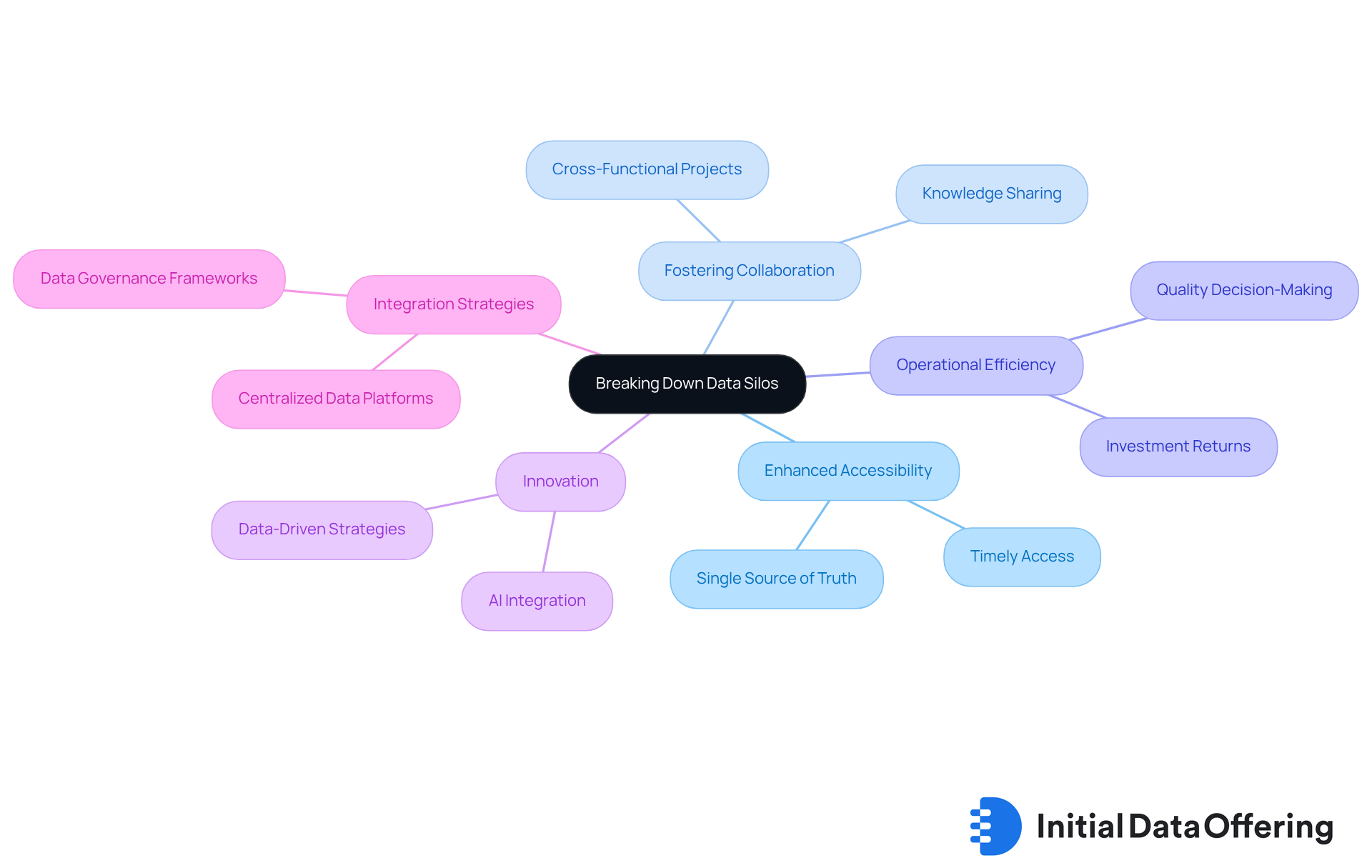
Security and Privacy: Protecting Sensitive Data
Organizations must prioritize information security and privacy to safeguard sensitive details and comply with regulations. One critical feature is the establishment of strong encryption protocols. The advantage of this is clear: the typical cost of a breach incident across organizations globally is $4.44 million. This statistic highlights the financial consequences of insufficient encryption, making it evident that investing in robust encryption is not just a precaution but a necessity.
Access controls, such as multi-factor authentication and role-based access, further enhance security. These measures ensure that only authorized individuals can access sensitive information, significantly reducing the risk of unauthorized access. Regular audits and assessments are also crucial. They help identify vulnerabilities and ensure compliance with evolving regulations, reinforcing the organization's commitment to security.
Moreover, promoting a culture of privacy awareness among employees is essential. Did you know that 88 percent of cybersecurity incidents are attributed to human error? This statistic underscores the importance of thorough training programs, which can greatly diminish the likelihood of breaches. For instance, entities that have implemented stringent access controls and encryption techniques, like Database Activity Monitoring tools, have reported a significant reduction in breaches. This showcases the effectiveness of these strategies in safeguarding sensitive information.
In conclusion, organizations that prioritize these security measures not only protect their sensitive data but also enhance their overall resilience against potential threats. How prepared is your organization to tackle these challenges?
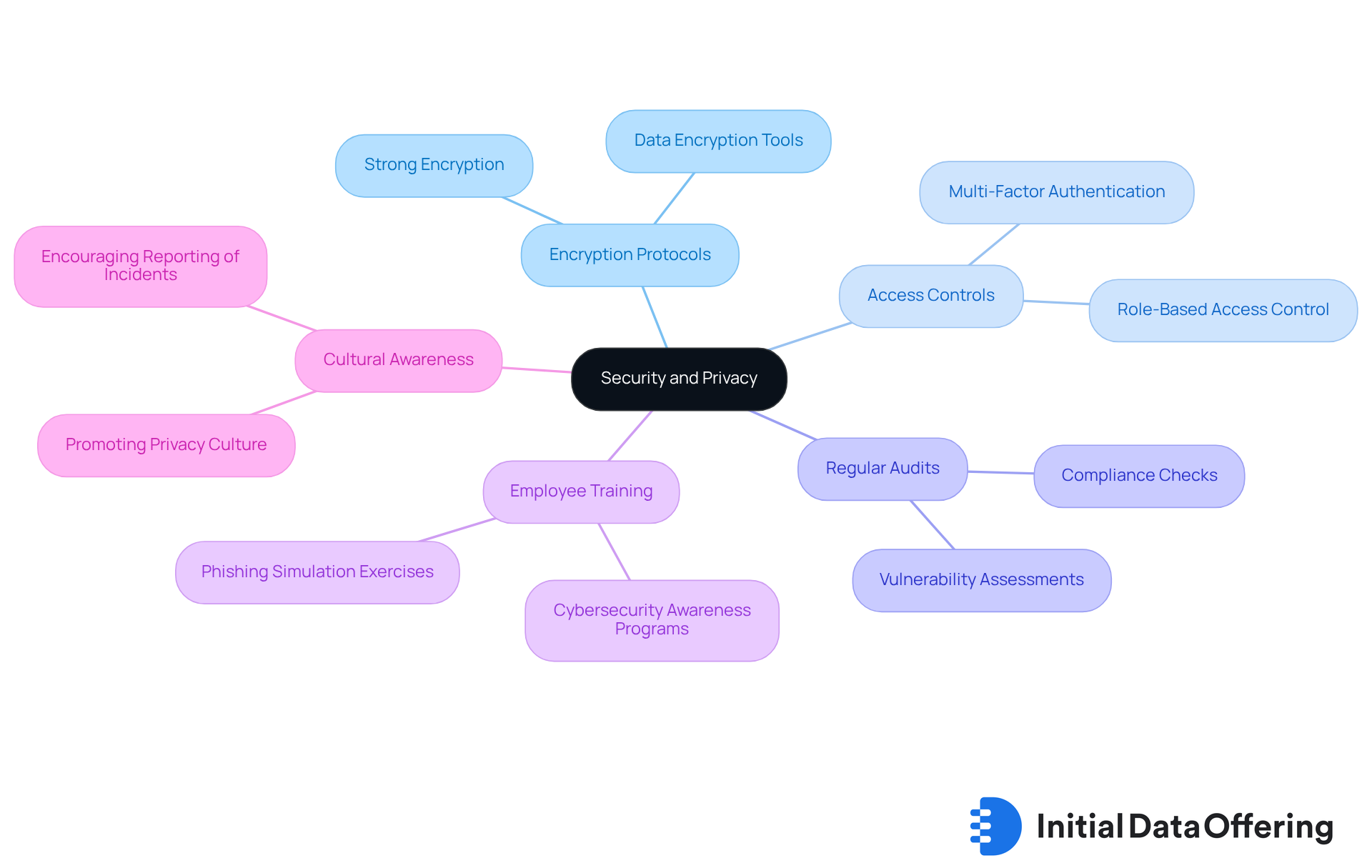
Best Practices: Effective Management of Data Resources
To effectively manage information resources, organizations must implement an enterprise data strategy that enhances quality, accessibility, and security. Strong information governance policies are vital; they outline roles, rules, and processes that ensure accuracy and compliance with regulations like GDPR and CCPA. By investing in training for information literacy, organizations empower employees to utilize information effectively, fostering a culture of informed decision-making. Furthermore, leveraging advanced analytics tools can provide actionable insights, driving strategic initiatives across the organization.
Ongoing assessment and improvement of information management procedures are essential for optimizing the value of assets within the enterprise data strategy. For instance, General Electric's successful digital transformation is largely attributed to its comprehensive information governance framework, which includes practices like information stewardship and responsibility. This approach enhances information consistency and standards, ultimately boosting operational efficiency. Similarly, companies like Coca-Cola maintain consistent client information across various regions by applying information cleansing, standardization, and validation practices. This showcases the significance of information quality in international operations.
Moreover, the global enterprise information management market is projected to grow by 12.4% annually from 2025 to 2030, underscoring the necessity for companies to prioritize these practices. By concentrating on an enterprise data strategy, organizations can safeguard their data and unlock its full potential. This leads to improved outcomes and competitive advantages in today's data-driven landscape. How can your organization enhance its information management practices to stay ahead?

Conclusion
An effective enterprise data strategy is fundamental for organizations aiming to harness the full potential of their data. By focusing on essential elements like:
- Centralized dataset discovery
- Robust data governance
- Alignment with business objectives
- Strategic technology investments
companies can create a cohesive framework that drives innovation and enhances decision-making capabilities. The integration of self-service analytics and a strong data culture empowers employees, fostering an environment where informed, data-driven decisions become the norm.
Key insights throughout this discussion highlight the importance of:
- Dismantling data silos
- Ensuring security and privacy
- Employing performance measurement frameworks
Each of these components plays a critical role in optimizing data management practices and ensuring compliance with regulatory standards. Organizations that prioritize these strategies are better positioned to improve operational efficiency, enhance collaboration, and ultimately achieve their strategic goals.
In a rapidly evolving data landscape, the significance of a well-defined enterprise data strategy cannot be overstated. As organizations strive to remain competitive, taking proactive steps to implement best practices in data governance, technology investment, and cultural alignment will unlock new opportunities for growth and innovation. Embracing these principles not only safeguards sensitive information but also empowers teams to leverage data as a strategic asset. This paves the way for informed decision-making and sustainable success.
Frequently Asked Questions
What is the Initial Data Offering (IDO)?
The Initial Data Offering (IDO) is a centralized hub designed to streamline the process of launching and discovering new datasets, enhancing accessibility for businesses, researchers, and organizations.
What are the advantages of using the IDO?
The IDO improves efficiencies and enhances decision-making capabilities by connecting information providers with potential purchasers, ensuring access to the latest trends and insights.
How does community involvement benefit the IDO?
Community engagement fosters collaboration and knowledge exchange, leading to better outcomes for all parties involved and establishing IDO as a preferred choice for information exchange.
What is the significance of data governance in an enterprise data strategy?
Data governance is essential for establishing policies and procedures that guarantee accuracy, security, and compliance with regulations like GDPR and HIPAA, helping organizations navigate compliance challenges.
What are key components of an effective enterprise data strategy for information governance?
Key components include assessing the information landscape, defining ownership, implementing access controls, conducting regular audits, and fostering a culture of accountability among information stewards.
How does prioritizing information quality and compliance benefit organizations?
Organizations that prioritize information quality and compliance report improved analytics and insights, with 58% citing enhanced information quality as a key benefit of their governance programs.
Why is it important for organizations to align their data strategy with business objectives?
Aligning data strategy with business objectives enhances the effectiveness of information initiatives, improves market positioning, and stimulates substantial growth.
What can happen to organizations lacking a clear information strategy?
Organizations without a clear information strategy experience slower decision-making processes and may miss out on significant growth opportunities.
How can organizations ensure their information initiatives are effectively aligned with their goals?
Organizations can establish measurable objectives and recognize specific use cases to drive improvements in performance and growth.